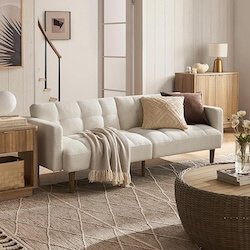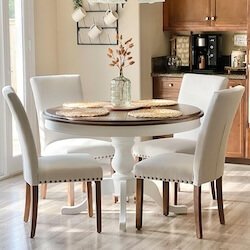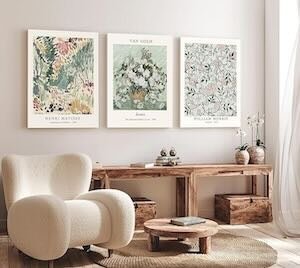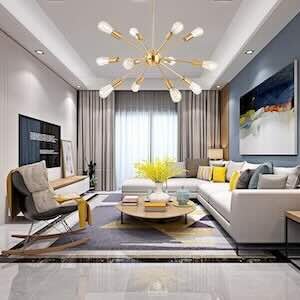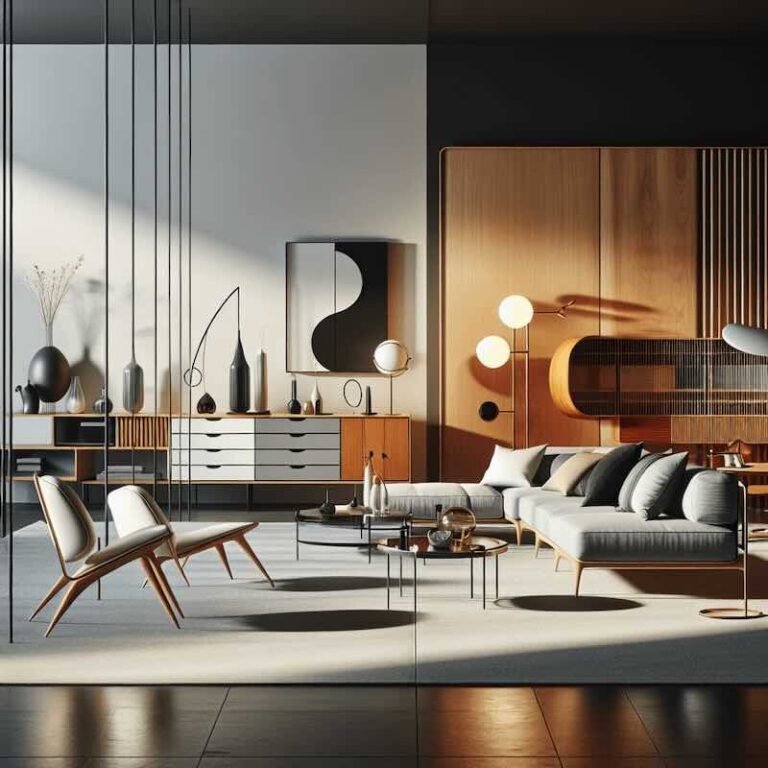
Modern and Mid-Century Modern (MCM) design has surged back into popularity in recent years. The kind of design renaissance reflected by these styles — with their clean lines and functional elegance, connotes a new generation. Now, what if we mix the two? This convergence is reshaping today’s spaces in exciting ways, providing home dwellers and designers the opportunity to design environments that are classic yet not dated. This fusion is changing the face of interior design, creating real spaces to take action and move.
The Roots of Modern and MCM Design
There is a rich history behind modern and MCM design that has heavily influenced what we consider contemporary, aesthetically speaking. Modern design originated in the late 19th century and is a resultof contemporary style, embracing pureness of type, very little… This concept is inspired by key influencers such as architects Ludwig Mies van der Rohe, and Le Corbusier who introduced minimalism in design with the famous phrase “less is more”
Mid-Century is a style that first exploded onto the scene in, well, you guessed it: the middle of this century (1940s-1960s-ish). Organic forms,heart and soul simplicity,and a seamless connection to nature. People like Charles and Ray Eames, Eero Saarinen, and George Nelson all had a hand in making the aesthetic what it is. I Would like this picture even more if it was color, but by the time you see all the other pictures to come in this post… Their new materials, plastic and plywood allowed Verner Panton to make some of these s shapes for his interior designs.
The end of the 1940s saw several major developments that had implications both on design philosophy and practical applications. After the war, we wanted a more practical home that offered function without sacrificing aesthetic value and MCM took off like wildfire. The blending of art with utility established the foundation for modern fusion trends.
Key Features and Characteristics of Modern Design
Simple, clean lines and monochromatic color palette — these are the traits of modern design. It is frequently combined with modern materials such as steel, glass, and concrete — highly attractive in appearance. It has a function-first design approach with all elements serving to achieve that.
Natural light and open spaces, simple materials. Furniture is typically modern in design with functionality of form as a priority. The colour palette features predominantly neutral tones, allowing the muted architecture and material selection to be its design centrepiece.
Key Features and Characteristics of Mid-Century Modern Design
Organic forms, connection to the outdoors, and use of new materials on this phrase are what have really put Mid-Century Design in world history books. The home is distinguished by these natural finishes, which perfectly conjoin elements usually reserved for an indoor setting as well with outdoor spaces. The trend is typically characterized by bold colours, geometric patterns and unique furniture pieces.
Low slung furniture with tapered legs mixed textures The palette of shades is presents a refined mix -scope in earthly notes with vivid accents. Mid-Century Modern interiors are functional yet warm, and represent a harmonious design style.
Understanding Their Differences and Similarities
Though it is occasionally confused for contemporary design, modern interior design refers to a distinct style defined by simplicity, minimalism and an absence of ornamentation. The demarcation between modern and mid-century modern is such that the former represents a design aesthetic, encompassing many more styles than just this one high point of American history.
Well for starters, the modern interior design is a way of creating open floor plans in clutter-free spaces. This design idea promotes neutral color scheme like whites, greys and blacks to give a peaceful and relaxation feeling. It emphasises the goal to strike a balance between
Though both mid-century modern and modern design give an importance to functionality, simplicity and clean lines but what makes sense about a slight departure in most recent years is that the latter has seen more direct shapes & forms, while Mid century Modern (MCM) embraced curved elements like gentle arcs or rounded curves for textures. This tapered form moves away from the controlled geometric lines and hard angles of modern design. The interior furniture of mid-century is generally with the wood, a little leather and warm metal finishes; creating contrast into own characteristic daring presence.
In stark contrast, the former and this utilize clean lines without a lot of flourish on the exterior which are both worth noting. It is from this collective creed that they merge as a seamless integration, appearing in homogeny across planes making rooms both comfortable and contemporary.
Distinctive Elements of Mid-Century Modern Furniture: Colors and Patterns
Before you go through this homepage content, let me brief you in one thing: In order to get a foundation on how mid-century modern design can work with your current interior setting, find out the essential characteristics of both styles. Mid-century Modern Mid-Century modern furniture is characterized by its clean lines, tapered legs and organic shapes. Design classics like the Eames Lounge Chair, Arne Jacobsen’s Egg chair and Saarinen Tulip Table influence designers to this day.
As for colors, there is a mix of earthy tones and bright shades in mid-century modern design. The base colors for the fall wardrobe are frequently olive green, mustard yellow and deep burgundy accented with either turquoise or coral or teal. Accent walls, decorative accessories and textiles are great ways these hues can be brought into contemporary interiors to add some depth and character.
Because of this, patterns are a huge aspect in mid-century modern design and give it character and liveliness. In rugs, wallpapers and upholstery: Geometric patterns are an abstract motif or bold graphics often appear. Use these patterns into the modern style of interior to create dynamism and movement creating an interesting aesthetic making a space come alive.
Navigating the Fusion in Your Home
Integrating modern and MCM design elements into your home is a delicate process. To kick things off, choose highlight pieces that represent the spirit of each style. For example, try a contemporary dining table with simple lines and match it up with MCM-style chairs that have organic curves. This way things feel balanced but now with style!
Think of Color Palettes As Your Design Anchor Current interior design colors are neutrals like white, gray and black, while MCM values natural hues with accentuates color. Mix these palettes to give more depth and dimension to your space. Add a few vibrant throw pillows or artwork that sets the color palette for them throughout your entire open transitional area.
The dining room you see in image receipts over modern design, using a unique lighting constellated as chandelier while encircle the table and larger–scale pieces take command to make everyone clear what style want. You can always add an air of nostalgia by blending the new with MCM aesthetics.
Trends, Innovations, and the Future of Fusion
This blending of contemporary design with MCM is an ongoing process that reflects the way current trends are moving towards sustainable and modern living. Eco conscious materials and practices have made their way into the pieces from more designers, which works for these two camps. From reclaimed wood and recycled metals to energy-efficient lighting, green materials are must-haves for current fusion interiors.
One other trend is incorporating smart technology with design. An MCM-style living room decked out with a contemporary, smart thermostat and HempMod sit-to-stand desk chair? We can’t either. All of these developments make life easier and more comfortable, all the while retaining its appearance.
This bodes well for future fusion designs, which promise to be even more innovative and creative. And as technology progresses and design boundaries grow ever wider, homeowners and designers will find more chances for experimentation with new materials, methods of fabrication, or overall concepts. The marriage between contemporary and MCM style is something that will indeed never grow old, driving creativity for years to come.
The Appeal and Benefits of Fusion Design
Fusion design comes with unique functionalities and this enhances the degree of comfort into a space. This blend of contemporary and MCM characteristics creates a timeless appearance that goes beyond fads. The result is a home that stays stylish and hip regardless of the trend in design.
Mood and AtmosphereOne of the biggest payoffs with fusion design is comes to mood and atmosphere. Sleekness and polished open spaces are classic signatures of modern design. On the other hand, MCM retains a warmth and organic feel in its many elements which helps to give your home (or office) that cozy feeling.
Fusion design can serve more than just an ornamental purpose — it also helps improve functionality of a space, and hence its value. Introduce multipurpose furniture and better layouts to help your home work around you. This combination of styles also makes your home more marketable to a consumer who appreciates art and design, since it showcases that you took the time and care in finding pieces old and new.
Budgeting and Discovering Genuine Pieces
Mix Modern and Mid-Century styles for a furniture fusion design. Think sculptural couches with a mid-century modern inspiration, versatile coffee tables that employ natural hues like teak or Mahogany and even prominent pieces of furniture such as the Eames Lounge. Get an up-to-date look to your space with modern pendant lights, MCM base lamps as well and go for bookshelves that combine current elements with the one of mid-century. In turn, the approach results is quite a harmonious space of modern simplicity paired with that nostalgic charm in plenty!
Balancing Modern and Mid-Century Modern design can be a rewarding task, but it can also be quite challenging. Some of the important points for designers include establishing a budget, investigating both online and offline shops to find options that are not only functional but also durable in nature while looking for interesting material.
Mopio Aaron Couch, Small Sofa, Futon, Sofa Bed, Sleeper Sofa, Loveseat, Mid Century Modern Futon Couch, Sofa Cama, Couches for Living Room, Bedroom
- 30-Day Return with 1 Year Warranty
- Spill-resistant & Texture-rich Bouclé Fabric
- Versatile Functionality
- Space Efficiency
- Firm & Sturd
- Timeless Design
- Easy Maintenance
- Simple Assembly
COLAMY Upholstered Parsons Dining Chairs Set of 4, Fabric Dining Room Kitchen Side Chair with Nailhead Trim and Wood Legs
- SIMPLE YET ELEGANT LOOK
- SELECTED MATERIAL- Environment BUIT TO BE COMFORT
- VERSATILE
- EASY TO ASSEMBLY AND EASY TO MOVE
Induslyfe Large Framed Sage Green Vintage Wall Art Canvas Decor Set of 3, Matisse Wall Art Prints Poster Mid Century Modern Art, Aesthetic Floral Botanical wall art
- FRAMED VINTAGE ART: Complements sage green and boho décor, size 18×24 inches.
- MASTER ARTWORK SET: Perfect for kitchen, office, or dorm walls.
- RETRO CANVAS PRINTS: Boho style with geometric and botanical elements.
- AESTHETIC WALL ART: Ideal for various room decors and settings.
- GIFTABLE: Charming for occasions like Christmas or anniversaries.
BONLICHT Contemporary 12 Light Brushed Brass Sputnik Chandelier Mid Century Modern Sputnik Kitchen Island Dining Room Pendant Lighting Gold Ceiling Hanging Light Fixture for Living Room Bedroom Bar
- Mid-century design adds modern and stylish appeal to any space.
- Swivel canopy allows installation on vaulted or sloped ceilings.
- Pre-wired fixture for easy installation; screw branches onto central ball.
- Compatible with E26 LED, Incandescent, CFL, and halogen bulbs.
- Fully dimmable with dimmable bulbs and compatible dimmer switch.
- Eye-catching sputnik design ideal for various residential and commercial spaces.
- Adjustable hanging height to suit different ceiling heights.
- Perfect for living rooms, dining rooms, kitchens, bedrooms, and more.
Conclusion
In addition to a trend, the merging of modern and MCM design is very much an art that appreciates one side while revealing another. Understanding the origins of these styles and how they can work together will help you create beautiful, yet functional living spaces. The opportunities are infinite, Whether you a design student or homeowner or professional.
If you are ready to welcome the new age of fusion into your projects, think about bundling a few tips and ideas out of this article. The key here (as I’ve said a million times!) is merging opposing elements you’re being contradictory by using this, so don’t be worried to mix and match other styles: that’s where the fusion layout.
If any of you are digging deeper, there is a plethora or design professionals and resources to check out for modern identifies as well as MCM style. This can offer guidance and insight as you get started with your own fusion design.
References
- Barlow, C. (2019). Mid-Century Modern Design: A Complete Guide. New York: Design Publishers. Link
- Smith, J. A. (2021). “The Evolution of Home Interiors: 20th Century to Present.” Journal of Interior Design, 35(2), 45-67. [Link](#smith2021)
- Thompson, R. (2020). Fusing Styles: The Art of Interior Design. London: Creative Spaces Press. Link
- Harris, L. (2022). Embracing a Balanced Aesthetic: Modern Meets Mid-Century.” House & Home Magazine, 12(6), 28-30. [Link](#harris2022)
- Johnson, T. & Lee, K. (2023). “The Rise of Fusion Design: Trends and Innovations.” Interior Design Trends Review, 40(1), 10-15. [Link](#johnson2023)

